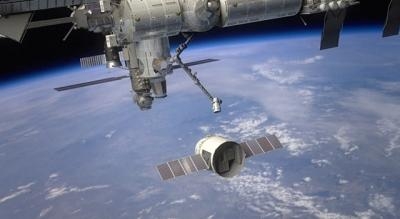Fri, Oct 05, 2012
Each Will Study The Effects Of Microgravity On Physical, Chemical, Or Biological Systems
Twenty-three microgravity experiments designed by participants of the Student Spaceflight Experiment Program (SSEP) will become part of space history Oct. 7. They will be launched to the International Space Station aboard the SpaceX Dragon, the first commercially developed and built American spacecraft to fly a resupply cargo resupply mission to the station. Twelve of the SSEP experiments are getting a second flight opportunity. They were delivered to the space station on a SpaceX demonstration mission in May, but were not completed. The other 11 experiments are new.

Each experiment will study the effects of microgravity on physical, chemical and biological systems. The students have been immersed in every facet of research, from defining investigations to designing experiments, writing proposals, and submitting to a formal NASA review for selection of flight experiments. The 23 experiments represent more than 7,000 students and almost 2,000 proposals. "SSEP offers a unique flight opportunity that allows students to experience both the excitement and the challenges inherent in conducting research in a microgravity environment," said Roosevelt Johnson, deputy associate administrator for education at NASA Headquarters in Washington. "It really is STEM [science, technology, engineering and mathematics] in action, using the International Space Station -- which has America's only orbiting National Laboratory -- to host these students' science experiments."
SSEP began in June 2010 as a cooperative venture by the National Center for Earth and Space Science Education (NCESSE) and NanoRacks LLC, a national STEM education initiative. The organizations work together to give hundreds of students across a community the opportunity to design and propose real experiments to fly in low Earth orbit. Teams submit formal flight experiment proposals, and a formal proposal review process selects the flight experiment for the community. A suite of programs leverages the flight experiment design competition to engage the entire community, including a mission patch art and design competition.
SSEP payloads were flown in 2011 aboard space shuttles Endeavour and Atlantis on their respective STS-134 and STS-135 missions. The third round of experiments in May was the first to be conducted in orbit by space station astronauts. Next week's Dragon launch is the fourth flight opportunity. A fifth suite of experiments is scheduled for spring 2013.
More than 100 SSEP students, teachers, and family members will travel to Florida to attend the SpaceX launch from Cape Canaveral Air Force Station. SSEP is one of many programs that use NASA's science and exploration missions to encourage students to pursue a STEM-centric school curriculum. NASA's Office of Education is committed to inspiring and developing the next generation of scientists and engineers through experiential, hands-on learning.
More News
The Industry Continues to be Rocked By Some Questionable Operations Recent investigations and a great deal of data has resulted in ANN’s SportPlane Resource Guide’s rep>[...]
Make Sure You NEVER Miss A New Story From Aero-News Network Do you ever feel like you never see posts from a certain person or page on Facebook or Instagram? Here’s how you c>[...]
Visual Approach Slope Indicator (VASI) An airport lighting facility providing vertical visual approach slope guidance to aircraft during approach to landing by radiating a directio>[...]
Airport Marking Aids Markings used on runway and taxiway surfaces to identify a specific runway, a runway threshold, a centerline, a hold line, etc. A runway should be marked in ac>[...]
Aero Linx: The Skyhawk Association The Skyhawk Association is a non-profit organization founded by former Skyhawk Pilots which is open to anyone with an affinity for the A-4 Skyhaw>[...]
 Unfortunate... ANN/SportPlane Resource Guide Adds To Cautionary Advisories
Unfortunate... ANN/SportPlane Resource Guide Adds To Cautionary Advisories ANN FAQ: Turn On Post Notifications
ANN FAQ: Turn On Post Notifications ANN's Daily Aero-Term (04.29.24): Visual Approach Slope Indicator (VASI)
ANN's Daily Aero-Term (04.29.24): Visual Approach Slope Indicator (VASI) ANN's Daily Aero-Term (04.28.24): Airport Marking Aids
ANN's Daily Aero-Term (04.28.24): Airport Marking Aids ANN's Daily Aero-Linx (04.28.24)
ANN's Daily Aero-Linx (04.28.24)



